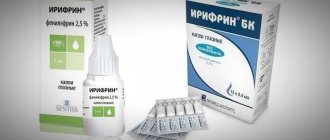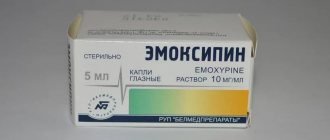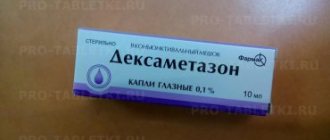Side effects
About one tenth of people using Signicef eye drops experience unwanted side effects. The most common is a decrease in visual acuity. Also, mucous strands may appear in the eye.
Side effects such as allergic reactions, headaches and inflammation of the nasal mucosa occur much less frequently. On the part of the eyes, in rare cases, the following undesirable effects are possible:
- feeling of discomfort;
- feeling of burning and sand in the eyes;
- painful sensations in the eye;
- inflammation of the upper and lower eyelids;
- hyperemia of the eyelids and/or conjunctiva;
- lacrimation, mucous discharge;
- swelling of the conjunctiva of the eyeballs (chemosis);
- photophobia;
- conjunctivitis, including granular (follicular conjunctivitis);
- dermatitis;
- xerophthalmia (dry cornea and conjunctiva), in other words, dry eye syndrome.
Description and instructions for the drug Signicef
Signicef is an eye drop with an antibacterial effect.
The antibiotic in their composition is levofloxacin from the class of fluoroquinolones. This substance is effective against gram-positive aerobic bacteria (Staphylococcus aureus, streptococci), enterobacteria and gram-negative anaerobic microorganisms. The drug is also known to be active against chlamydial infections. Applicable for:
- Eye infections caused by microorganisms sensitive to the drug;
- Prevention of infection in the postoperative period;
Treatment with this drug, according to the instructions for the drug Signicef, lasts five days. For the first two days, eye drops are instilled into the affected eye every two hours (1-2 drops). In total - up to 8 times a day (during the waking period). Then, for the remaining three days, drop four times.
Contraindicated for:
- Treatment of children in the first year of life;
- Pregnancy and lactation;
- with caution when -
- Treatment of all minor patients;
Side effects
Instillation of Signicef eye drops can lead to the appearance of mucous strands and impaired visual acuity. Symptoms such as:
- Swelling of the eyelids;
- Dry eye syndrome;
- Overgrowth of the conjunctiva;
- Mucous discharge;
- And so on.
special instructions
It is prohibited to instill Signicef under the conjunctiva of the eyes, and the drug cannot be administered subscleral by injection.
If the patient, in addition to the antibacterial agent Signicef, is prescribed other agents in the form of eye drops, then a time interval of at least 15 minutes between their use must be observed.
Wearing contact lenses is not recommended during treatment with Signicef eye drops. This is due to the fact that the drug contains benzalkonium chloride. It is absorbed by contact lenses and can negatively affect your vision. The color and transparency of the lenses may change.
When performing instillation (putting drops into the eye), you should refrain from contacting the dropper bottle with the tissues of the eye. Otherwise, there is a risk of contamination of the treatment solution.
Signicef® eye drops—instructions for use
Signicef® must be used in strict accordance with the factory instructions.
Signicef® shows the highest effectiveness in the treatment of barley and various inflammations of the conjunctival tissues of the eye.
The main active ingredient of the drug is levofloxacin. The antibiotic has a bactericidal effect on bacteria by blocking the synthesis of bacterial DNA.
Levofloxacin is effective against enterobacteria, Pseudomonas aeruginosa, Hemolytic bacillus, gonococci, pyogenic streptococci, Staphylococcus aureus, chlamydia, etc.
Is Signicef® an antibiotic or not?
Signicef® (levofloxacin) is a 2nd generation fluoroquinolone antibiotic, which is essentially the L-isomer of ofloxacin. Drops are effective against gram-positive and gram-negative microflora.
Pharmacological group
Signicef® eye drops are a medication with an antibacterial mechanism of action. According to its chemical formula, it belongs to the group of fluoroquinolones and is intended for local use in the treatment of various types of ophthalmological pathologies.
The main active component of the drops is levofloxacin. The mechanism of action is based on blocking DNA gyrase and suppressing bacterial synthesis at the cellular level. This is a potent therapeutic agent that destroys bacteria resistant to penicillin antibacterial substances.
Signicef® composition
The main active ingredient of the drops is levofloxacin, which is present in the sterile liquid at a concentration of 0.5%, that is, 1 mg of the drug solution contains 5 mg of the active ingredient.
Signicef® release form
The medicine is produced in the format of eye drops in a plastic bottle, which is equipped with a special dropper - 5 ml, with a screw-on cap; in addition, the dropper is enclosed in a cardboard package with instructions for it on paper.
Photo of packaging of Signicef® eye drops (levofloxacin 0.5%)
Recipe in Latin
Rp.: Signicefi 0.5% - 5 ml.
D.S. Place 2 drops into the affected eye.
Indications – what does Signicef® help with?
The main effect of the drops is in pathological conditions of the eyes, such as: keratitis (inflammation of the cornea of the eye), blepharitis (inflammation of the edges of the eyelids), stye. Any other infections caused by bacterial microflora highly sensitive to levofloxacin (inflammation of the conjunctival membrane of the eye, blepharoconjunctivitis).
In addition, the drug is used for prophylactic purposes against possible infectious complications after eye surgery, to prevent the occurrence of postoperative infections.
Read further: Photos, classification, symptoms and treatment of eye disease blepharitis
Contraindications to the use of Signicef®
Drops should not be used:
- pregnant and breastfeeding patients;
- age group up to one year, that is, the use of Signicef® for newborns is prohibited;
- in case of individual hypersensitivity to quinolones or other components included in the treatment formula.
It is necessary to follow precautions and doctor's recommendations when using drops in childhood until adulthood.
Wearing soft contact lenses in everyday life is also of particular importance, since Sigicef® eye drops contain benzalkonium chloride, which can be absorbed into the structure of the lens and increase the risk of adverse reactions. Therefore, it is better to abandon them during therapy.
Dosage and method of use Signicef®
The usual dosage prescribed by an ophthalmologist for the treatment of adults and children under 1 year of age is to instill 2 drops into the eye affected by the disease, with a time interval of two hours (8-9 times / day), thus, the drops need to be used only in the first two days . Then, from the third to the fifth day - 4 times a day, 2 drops in one eye.
The duration of the therapeutic course is 5 days. According to indications, treatment can be extended.
Before opening the bottle, you need to wash your hands with special care, you can treat them with chlorhexidine, unscrew the cap, then push the lower eyelid down with your fingers and drip two drops.
It is worth remembering that Signicef® solution cannot be injected into the anterior chamber of the eye and under the conjunctiva.
Side effects and effects of Signicef®
When exposed to drops, negative consequences may occur (identified in only 10% of patients), they usually occur in the form of:
- decreased visual acuity, strands appear on the mucous membrane of the eye;
- the occurrence of chemosis, blepharitis, growths that externally resemble small papillae on the conjunctiva;
- swelling of the eyelid, feeling of pain in the eyes, painful itching at the site of contact with drops;
- general deterioration of vision, unnatural redness of the mucous membranes and tissues of the eye;
- “dry eye” syndrome, which spontaneously disappears over time after withdrawal;
- pathological proliferation of lymphatic tissue in the conjunctiva in the form of follicles;
- contact dermatitis, fear of light, abnormal redness of the skin;
- allergic manifestations, rhinitis, headaches.
If the dosage was exceeded when using drops, this often causes unpleasant feelings - burning, excessive soreness of the eyes. Measures to alleviate the condition should be taken immediately - it is necessary to perform several rinses with clean, cool boiled water until the negative phenomena disappear.
Read further: TOP 5 eye drops with a broad-spectrum antibiotic
Signicef® during pregnancy and breastfeeding
There is no reliable information about the safety of prescribing drops to pregnant patients.
In this regard, the use of Signicef® drops during pregnancy and lactation does not justify the possible risks, therefore it is recommended to use other medications that do not have such restrictions.
If drops must still be used during breastfeeding, then during the period of conservative treatment it is advisable to transfer the child to feeding with ready-made formulas.
Alcohol compatibility
There is no reliable information about compatibility, or lack thereof, with alcohol.
There is a general recommendation that is valid for everyone - antibiotics and alcohol do not combine, and unpredictable allergic reactions of the body may occur, or the effectiveness of the antibacterial agent will be reduced significantly, and persistent resistance of pathogenic bacteria to the active ingredient of the drops may occur.
Storage conditions for Signicef®
The storage mode must correspond to temperature limits from 100C to 250C. Direct sunlight on the bottle is completely excluded. Children's access, in order to avoid negative consequences, must be strictly limited and controlled.
Interaction with other drugs
There is no data on clinical studies that were conducted to study drug interactions with Signicef.
When taking the active substance Levofloxacin simultaneously with non-steroidal anti-inflammatory drugs, the risk of developing seizures increases. The effect of hypoglycemic agents with Levofloxacin can cause both an increase and a decrease in blood glucose levels.
The entry into the systemic circulation of levofloxacin administered by ocular instillation is negligible, therefore there are no clinically pronounced effects from interactions between different drugs with Signicef.
How to use Signicef?
As a rule, depending on the disease and its degree of development, the dosage of Signicef may vary significantly.
Let us give the main examples of the use of drops, which are prescribed in the instructions and are considered the most beneficial for the body among ophthalmologists.
- The usual dose, which is called a single dose, is the use of the drug in the form of four drops, two for each eye.
- To achieve the best result, it is recommended to take a loading dose of the drug, that is, eight times a day, every two hours, two drops in each eye. On the next and subsequent days, this dose is reduced by almost half, until recovery.
- You can use this drug yourself, but due to the fact that it contains a strong antibiotic, it is better not to risk your health and, despite studying the instructions, consult an ophthalmologist. The optimal time that can be allocated for treatment with Signicef is five days. Depending on the degree of the disease and the specific diagnosis, this period may be reduced or increased by two or three days.
Video - How to put drops into your eyes correctly
Contraindications for use
Of course, not every organism is able to receive only benefits from Signicef drops. The instructions for use contain a fairly impressive list of contraindications that can seriously aggravate the situation.
Since Signicef contains the antibiotic Levofloxacin, the use of this drug can be dangerous for some categories, like other drugs that contain antibiotics.
The drug should not be used:
- infants and children under the age of one year, and under the age of five years without instructions or a prescription from a doctor;
- at the time of the gestational period;
- at the time of lactation;
- and also if there is an individual intolerance to the drug or any substance in its composition.
Therefore, if you are preparing to use a drug such as Signicef for the first time, first consult with an ophthalmologist.










